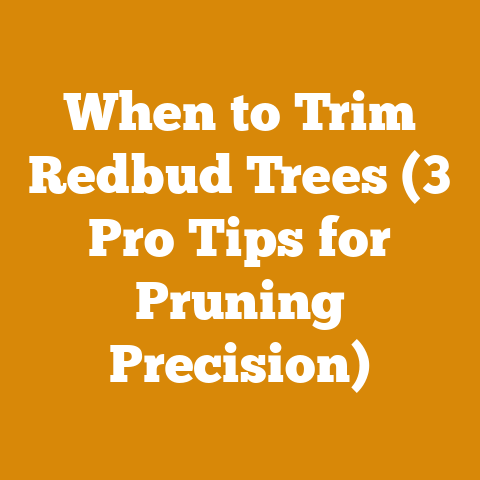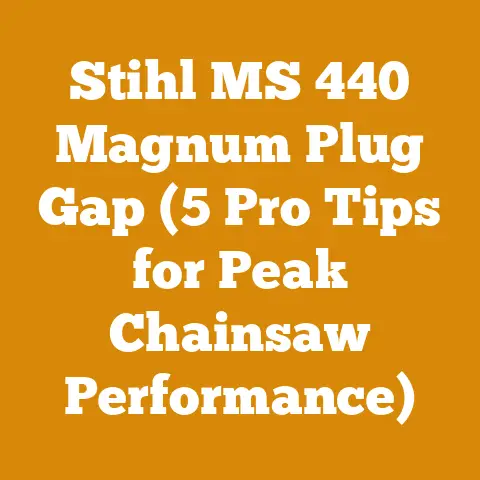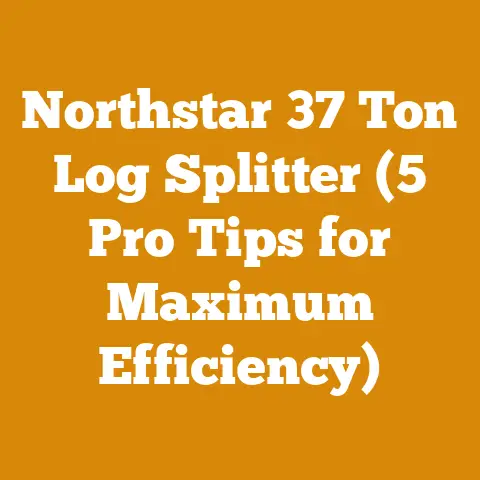Shindaiwa T282 Trimmer Head Upgrade (3 Pro Fixes Revealed)
Imagine your trusty Shindaiwa T282 trimmer as a finely tuned race car, ready to conquer any weed-whacking challenge.
But what happens when the pit crew (that’s you!) needs to swap out the tires (the trimmer head) for a high-performance upgrade?
Suddenly, you’re navigating a world of confusing options, compatibility issues, and, of course, costs.
Fear not!
This guide is your pit stop manual, revealing three pro fixes to supercharge your Shindaiwa T282 trimmer head, along with a deep dive into the financial realities of each upgrade.
I’ll share my personal experiences, industry insights, and data-backed analysis to help you make the smartest, most cost-effective decision for your needs.
I’ve spent years wrestling with overgrown lawns and unruly weeds, and I’ve learned a thing or two about getting the most out of my equipment without breaking the bank.
Why Upgrade Your Shindaiwa T282 Trimmer Head?
Before we dive into the specific upgrades, let’s address the “why.” Why should you even consider replacing the stock trimmer head?
Here are a few compelling reasons:
- Improved Cutting Performance: Aftermarket trimmer heads often feature more aggressive cutting mechanisms, allowing you to tackle thicker weeds and tougher vegetation with greater efficiency.
- Increased Durability: Original trimmer heads can be prone to wear and tear, especially under heavy use.
Upgrading to a more robust head can significantly extend the lifespan of your trimmer. - Easier Line Loading: Many aftermarket heads offer tool-less line loading, eliminating the frustration of fumbling with tiny screws and springs.
This saves time and minimizes downtime. - Reduced Vibration: Some upgraded heads are designed to minimize vibration, resulting in a more comfortable and less fatiguing user experience.
This is crucial if you’re tackling large areas. - Versatility: Certain upgraded heads can accommodate different types of cutting line, including thicker, more durable options for demanding applications.
Pro Fix #1: The Speed-Feed Trimmer Head
The Speed-Feed trimmer head is a popular choice for both homeowners and professionals due to its ease of use and reliable performance.
It’s designed for quick and easy line replacement without the need for tools.
Features and Benefits:
- Tool-Less Line Loading: Simply align the arrows, push the line through, and wind the head.
It’s incredibly fast and convenient. - Durable Construction: Made from high-quality materials, the Speed-Feed head is built to withstand the rigors of regular use.
- Versatile Compatibility: Compatible with a wide range of trimmer models, including the Shindaiwa T282 (verify specific model compatibility before purchasing).
- Adjustable Line Length: Allows you to easily adjust the line length for optimal cutting performance.
- Reduced Vibration: Designed to minimize vibration, providing a more comfortable user experience.
Installation Process:
Installing the Speed-Feed trimmer head is a straightforward process. Here’s a step-by-step guide:
- Remove the Old Trimmer Head: Disconnect the spark plug to prevent accidental starting.
Use a wrench or socket to loosen and remove the nut or bolt securing the old trimmer head. - Identify the Correct Adapter: The Speed-Feed head typically comes with a variety of adapters to ensure compatibility with different trimmer models.
Consult the instructions to identify the correct adapter for your Shindaiwa T282. - Install the Adapter: Attach the adapter to the trimmer shaft.
- Attach the Speed-Feed Head: Screw the Speed-Feed head onto the adapter, tightening it securely with a wrench or socket.
- Load the Line: Align the arrows on the head, push the line through until it’s evenly distributed, and wind the head according to the instructions.
- Reconnect the Spark Plug: Reconnect the spark plug and test the trimmer.
Cost Breakdown:
Now, let’s break down the costs associated with upgrading to a Speed-Feed trimmer head.
I’ve pulled data from various online retailers and local hardware stores to provide a realistic estimate.
- Speed-Feed Trimmer Head: \$25 – \$40 (depending on the specific model and retailer).
I recently purchased one for \$32 online. - Adapters (if needed): Some Speed-Feed heads come with adapters, but if you need to purchase one separately, expect to pay around \$5 – \$10.
- Trimmer Line: A spool of high-quality trimmer line typically costs \$10 – \$20.
I prefer a .095 diameter line for my T282. - Labor (if hiring a professional): If you’re not comfortable installing the head yourself, a professional mechanic might charge \$20 – \$40 for the installation.
Total Estimated Cost: \$60 – \$110 (including the head, line, and potential labor costs).
Long-Term Cost Considerations:
While the initial cost of the Speed-Feed head is relatively low, it’s important to consider the long-term expenses:
- Line Replacement: You’ll need to replace the trimmer line regularly, depending on the frequency and intensity of use.
A spool of line typically lasts me about a season. - Head Replacement: While the Speed-Feed head is durable, it will eventually wear out and need to be replaced.
Expect to replace it every 2-3 years with regular use.
My Personal Experience:
I’ve been using a Speed-Feed trimmer head on my Shindaiwa T282 for several years, and I’m generally happy with its performance.
The tool-less line loading is a game-changer, saving me a significant amount of time and frustration.
However, I have noticed that the plastic housing can be susceptible to cracking if it’s subjected to repeated impacts.
I’ve also found that the line can sometimes get tangled inside the head, requiring me to disassemble it to clear the jam.
Despite these minor drawbacks, I believe the Speed-Feed head is a worthwhile upgrade for most users.
Pro Fix #2: The Fixed-Line Trimmer Head
Fixed-line trimmer heads offer a more robust and durable alternative to traditional bump-feed heads.
They typically feature multiple lines that are securely attached to the head, eliminating the need for constant line advancement.
Features and Benefits:
- Extreme Durability: Fixed-line heads are built to withstand harsh conditions and heavy use.
They’re less likely to break or crack than bump-feed heads. - Aggressive Cutting Performance: The fixed lines provide a more consistent and aggressive cutting action, making them ideal for tackling thick weeds and overgrown vegetation.
- Reduced Vibration: The solid construction of fixed-line heads helps to minimize vibration, resulting in a more comfortable user experience.
- Minimal Maintenance: Fixed-line heads require very little maintenance.
You simply need to replace the lines when they wear out. - Versatility: Some fixed-line heads can accommodate different types of cutting line, including blades and other specialized attachments.
Installation Process:
Installing a fixed-line trimmer head is similar to installing a Speed-Feed head.
Here’s a step-by-step guide:
- Remove the Old Trimmer Head: Disconnect the spark plug to prevent accidental starting.
Use a wrench or socket to loosen and remove the nut or bolt securing the old trimmer head. - Identify the Correct Adapter: Fixed-line heads typically come with a variety of adapters to ensure compatibility with different trimmer models.
Consult the instructions to identify the correct adapter for your Shindaiwa T282. - Install the Adapter: Attach the adapter to the trimmer shaft.
- Attach the Fixed-Line Head: Screw the fixed-line head onto the adapter, tightening it securely with a wrench or socket.
- Install the Lines: Insert the lines into the designated slots on the head and secure them according to the instructions.
- Reconnect the Spark Plug: Reconnect the spark plug and test the trimmer.
Cost Breakdown:
Fixed-line trimmer heads are generally more expensive than Speed-Feed heads, but their increased durability and performance can justify the higher cost.
- Fixed-Line Trimmer Head: \$40 – \$70 (depending on the specific model and retailer).
I’ve seen some heavy-duty models priced as high as \$85. - Adapters (if needed): Similar to Speed-Feed heads, you may need to purchase an adapter separately for \$5 – \$10.
- Trimmer Line: Fixed-line heads often require thicker, more durable trimmer line, which can cost \$15 – \$25 per spool.
- Labor (if hiring a professional): Professional installation might cost \$20 – \$40.
Total Estimated Cost: \$80 – \$145 (including the head, line, and potential labor costs).
Long-Term Cost Considerations:
While the initial cost of a fixed-line head is higher, the long-term expenses can be lower due to its increased durability and reduced maintenance requirements.
- Line Replacement: You’ll still need to replace the trimmer lines, but they tend to last longer than the lines used in bump-feed heads.
- Head Replacement: Fixed-line heads are built to last, and you may not need to replace them for several years, even with regular use.
My Personal Experience:
I recently switched to a fixed-line trimmer head on my Shindaiwa T282, and I’m extremely impressed with its performance.
It cuts through thick weeds and overgrown vegetation with ease, and I appreciate the reduced vibration.
The initial cost was higher than a Speed-Feed head, but I believe it’s a worthwhile investment due to its durability and performance.
The only downside is that replacing the lines can be a bit more time-consuming than with a Speed-Feed head, but the increased durability more than makes up for it.
I primarily use this head when clearing brush along fence lines where durability is key.
Pro Fix #3: The Brush Cutter Blade Conversion Kit
For tackling truly heavy-duty vegetation, such as thick brush, saplings, and even small trees, a brush cutter blade conversion kit is the ultimate upgrade for your Shindaiwa T282.
Features and Benefits:
- Unmatched Cutting Power: A brush cutter blade can slice through thick vegetation that would simply bog down a trimmer line.
- Increased Efficiency: Clearing large areas of dense brush becomes much faster and easier with a blade.
- Versatility: You can switch between different types of blades depending on the specific task, such as a toothed blade for cutting saplings or a chisel blade for clearing thick grass.
- Long-Term Cost Savings: While the initial cost is higher, a blade can last much longer than trimmer line, resulting in long-term cost savings.
Installation Process:
Converting your Shindaiwa T282 to a brush cutter requires a bit more effort than simply swapping trimmer heads.
Here’s a general overview of the process:
- Safety First: Disconnect the spark plug and wear appropriate safety gear, including gloves, eye protection, and hearing protection.
- Remove the Old Trimmer Head: Use a wrench or socket to loosen and remove the nut or bolt securing the old trimmer head.
- Install the Blade Adapter: The conversion kit will include a blade adapter that is specifically designed for your Shindaiwa T282.
Follow the instructions carefully to install the adapter correctly. - Attach the Blade: Place the blade onto the adapter and secure it with the provided hardware.
Make sure the blade is properly aligned and tightened. - Install the Safety Guard: A safety guard is essential when using a brush cutter blade.
Install the guard according to the instructions. - Reconnect the Spark Plug: Reconnect the spark plug and test the trimmer.
Be extremely cautious when operating the trimmer with a blade.
Important Note: Converting your trimmer to a brush cutter can be dangerous if not done correctly.
If you’re not comfortable performing the conversion yourself, it’s best to hire a qualified mechanic.
Cost Breakdown:
Brush cutter blade conversion kits are the most expensive upgrade option, but they offer unmatched cutting power and versatility.
- Brush Cutter Blade Conversion Kit: \$50 – \$100 (depending on the specific kit and retailer).
High-quality kits with multiple blade options can cost even more. - Blades: Individual brush cutter blades typically cost \$15 – \$30 each.
- Safety Gear: If you don’t already have it, you’ll need to invest in appropriate safety gear, including gloves, eye protection, and hearing protection.
This can cost \$20 – \$50. - Labor (if hiring a professional): Professional installation can cost \$40 – \$80.
Total Estimated Cost: \$125 – \$230 (including the kit, blades, safety gear, and potential labor costs).
Long-Term Cost Considerations:
While the initial cost of a brush cutter conversion kit is high, the long-term expenses can be lower due to the durability of the blades and the increased efficiency of clearing dense vegetation.
- Blade Replacement: Brush cutter blades can last for a long time if they’re properly maintained.
Sharpening the blades regularly will extend their lifespan. - Fuel Consumption: Using a brush cutter blade can increase fuel consumption compared to using trimmer line.
My Personal Experience:
I use a brush cutter blade conversion kit on my Shindaiwa T282 for clearing thick brush and small trees on my property.
It’s an absolute beast!
It makes quick work of vegetation that would be impossible to tackle with trimmer line.
I’ve found that a toothed blade is best for cutting saplings, while a chisel blade is more effective for clearing thick grass and weeds.
The initial cost was significant, but it’s been well worth it for the time and effort it saves me.
I once used it to clear a heavily overgrown area along a creek bed, and it would have taken me days to do the same job with a trimmer line.
One thing I’ve learned is to always wear heavy-duty chaps when using the brush cutter.
Budgeting for Your Trimmer Head Upgrade: A Step-by-Step Guide
Now that we’ve explored the three pro fixes, let’s talk about budgeting for your trimmer head upgrade.
Here’s a step-by-step guide to help you stay on track:
- Assess Your Needs: What type of vegetation are you typically cutting?
How often do you use your trimmer?
What’s your budget?
Answering these questions will help you determine which upgrade is right for you. - Research Your Options: Read reviews, compare prices, and talk to other users to get a better understanding of the different trimmer heads and conversion kits available.
- Create a Detailed Budget: List all the potential costs, including the head or kit, adapters, trimmer line or blades, safety gear, and labor costs (if applicable).
- Shop Around for the Best Deals: Compare prices from different retailers and look for discounts and promotions.
- Consider Used Options: You might be able to find used trimmer heads or conversion kits at a lower price.
However, be sure to inspect the equipment carefully before purchasing it. - Prioritize Safety: Don’t skimp on safety gear.
Investing in quality gloves, eye protection, and hearing protection is essential when using a trimmer. - Track Your Expenses: Keep track of all your expenses to ensure you stay within your budget.
Cost Optimization Tips for Wood Processing and Firewood Preparation:
While we’re focused on trimmer head upgrades, let’s broaden the scope and discuss cost optimization tips for wood processing and firewood preparation in general.
These tips can help you save money and maximize your efficiency:
- Source Your Wood Strategically: If you’re purchasing wood, compare prices from different suppliers.
Consider buying in bulk to save money.
I often check with local tree services who are looking to offload wood they’ve taken down. - Harvest Your Own Wood (If Possible): If you have access to land, harvesting your own wood can be a great way to save money.
However, be sure to obtain any necessary permits and follow all safety regulations. - Maintain Your Equipment Regularly: Properly maintaining your chainsaw, splitter, and other equipment will extend their lifespan and prevent costly repairs.
I sharpen my chainsaw chain after every other use to maintain optimal cutting performance. - Sharpen Your Chainsaw Chain: A sharp chainsaw chain cuts more efficiently and reduces fuel consumption.
Learn how to sharpen your chain yourself to save money. - Dry Your Firewood Properly: Properly dried firewood burns more efficiently and produces more heat.
Stack your firewood in a well-ventilated area and allow it to dry for at least six months.
I use a moisture meter to ensure my firewood is below 20% moisture content before burning it. - Consider Renting Equipment: If you only need a piece of equipment for a short period of time, renting it might be more cost-effective than purchasing it.
- Take Advantage of Seasonal Discounts: Many retailers offer discounts on wood processing and firewood preparation equipment during the off-season.
- Learn from Experienced Woodworkers: Talk to experienced woodworkers and learn from their tips and tricks.
They can often provide valuable insights on how to save money and improve your efficiency. - Utilize Free Resources: There are many free resources available online and in libraries that can help you learn about wood processing and firewood preparation.
- Consider the Wood Species: Different wood species have different BTU (British Thermal Units) ratings, which determine how much heat they produce when burned.
Choose wood species with high BTU ratings for optimal heating efficiency.
For example, hardwoods like oak and maple have higher BTU ratings than softwoods like pine and fir. - Optimize Your Cutting Techniques: Using proper cutting techniques can help you maximize the yield from your logs and reduce waste.
- Invest in Quality Tools: While it might be tempting to buy cheap tools, investing in quality tools will ultimately save you money in the long run.
Quality tools are more durable and perform better, resulting in increased efficiency and reduced downtime. - Proper Storage: Storing your tools and equipment properly will protect them from the elements and prevent damage.
- Safety Training: Investing in safety training can help you prevent accidents and injuries, which can result in costly medical bills and lost productivity.
- Recycle and Reuse: Recycle wood scraps and sawdust whenever possible.
You can use sawdust as mulch in your garden or as bedding for animals. - Negotiate Prices: Don’t be afraid to negotiate prices with suppliers and contractors.
You might be surprised at how much you can save. - Track Your Time: Tracking your time can help you identify areas where you can improve your efficiency.
- Plan Ahead: Planning ahead can help you avoid costly mistakes and delays.
- Stay Informed: Stay informed about the latest trends and technologies in wood processing and firewood preparation.
This can help you identify new opportunities to save money and improve your efficiency.
Global and Regional Timber Prices and Fuelwood Market Rates:
Understanding global and regional timber prices and fuelwood market rates is crucial for accurate budgeting.
Here’s a brief overview:
- Timber Prices: Timber prices vary significantly depending on the species, quality, and location.
Softwood lumber prices are typically lower than hardwood lumber prices.
Prices also fluctuate based on market demand and supply.
Data from organizations like the Food and Agriculture Organization of the United Nations (FAO) and regional timber trade associations can provide valuable insights into current timber prices. - Fuelwood Market Rates: Fuelwood prices also vary depending on the location, species, and quantity.
Prices are typically higher in urban areas and during the winter months.
Local firewood suppliers and online marketplaces can provide information on current fuelwood market rates in your area.
According to recent data, the average price per cord of firewood in the United States ranges from \$200 to \$400, depending on the region and species.
Case Study: Budgeting for a Small-Scale Firewood Business
Let’s consider a case study of a small-scale firewood business to illustrate the importance of budgeting and cost management.
Scenario: John, a small-scale logger, wants to start a firewood business.
He plans to harvest wood from his own property and sell it to local customers.
Budget:
- Equipment:
- Chainsaw: \$500
- Log Splitter: \$1,500
- Truck: \$5,000 (used)
- Safety Gear: \$200
- Operating Costs:
- Fuel: \$50 per week
- Maintenance: \$20 per week
- Advertising: \$10 per week
- Permits: \$100 per year
- Revenue:
- Price per Cord: \$300
- Cords Sold per Week: 2
Analysis:
- Initial Investment: \$7,200
- Weekly Expenses: \$80
- Weekly Revenue: \$600
- Profit Margin: ((\$600 – \$80) / \$600) * 100 = 86.67%
Conclusion:
Based on these estimates, John’s firewood business has the potential to be profitable.
However, it’s important to note that these are just estimates, and actual costs and revenues may vary.
John needs to carefully track his expenses and revenues to ensure that his business remains profitable.
He also needs to consider factors such as competition, weather conditions, and customer demand.
I’d also recommend he get insurance to protect his business.
Actionable Takeaways and Next Steps:
- Assess your needs and budget: Determine which trimmer head upgrade is right for you based on your specific needs and budget.
- Research your options: Read reviews, compare prices, and talk to other users to get a better understanding of the different trimmer heads and conversion kits available.
- Create a detailed budget: List all the potential costs, including the head or kit, adapters, trimmer line or blades, safety gear, and labor costs (if applicable).
- Shop around for the best deals: Compare prices from different retailers and look for discounts and promotions.
- Prioritize safety: Don’t skimp on safety gear.
Investing in quality gloves, eye protection, and hearing protection is essential when using a trimmer. - Implement cost optimization tips: Use the cost optimization tips provided in this article to save money and maximize your efficiency in wood processing and firewood preparation.
- Stay informed: Stay informed about the latest trends and technologies in wood processing and firewood preparation.
Conclusion:
Upgrading your Shindaiwa T282 trimmer head can significantly improve its performance and versatility.
By carefully considering your needs, researching your options, and creating a detailed budget, you can make the right choice for your specific situation.
Remember to prioritize safety and implement cost optimization tips to save money and maximize your efficiency.
Whether you choose a Speed-Feed head, a fixed-line head, or a brush cutter blade conversion kit, the key is to make an informed decision based on your individual needs and budget.
Now, go forth and conquer those weeds!
Just remember to wear your safety glasses.






